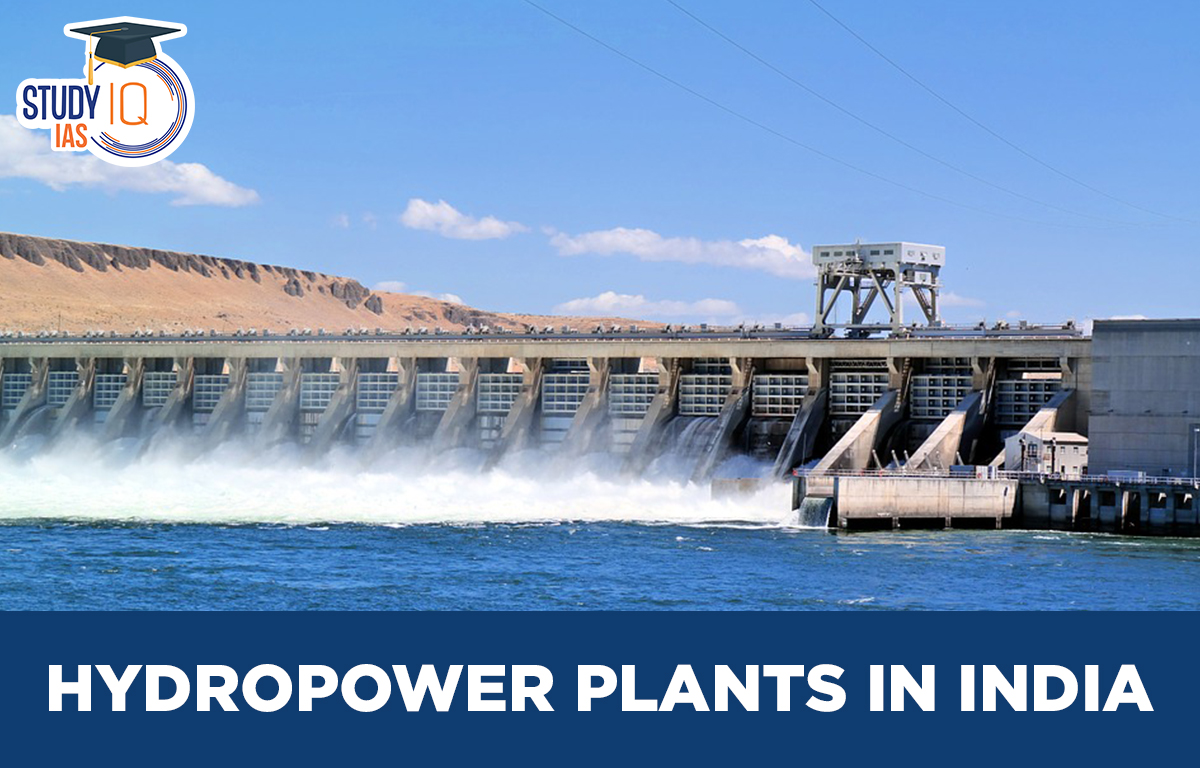Table of Contents
Hydropower Plants in India
Hydropower Plants in India: Hydropower is one of the cheapest and clean sources of energy. It refers to electricity generated by water. This energy is produced by using the gravitational force of falling or moving water. Hydropower projects come in two sizes: large and small. In India, small hydro projects have a capacity of 25 MW or less. Before 1989, the Ministry of Power managed hydropower, but then projects up to 3 MW were given to the Ministry of New and Renewable Energy (MNRE). In 1999, the MNRE took over projects up to 25 MW.
India has the potential to generate about 21133 MW of power from small hydro projects at 7133 sites. The hilly states like Arunachal Pradesh, Himachal Pradesh, Jammu & Kashmir, and Uttarakhand have about half of this potential. Other states with potential include Maharashtra, Chhattisgarh, Karnataka, and Kerala. The MNRE is focusing on these states to promote small hydro projects.
In India, the total potential for hydroelectric power is about 148700 MW. Out of this, 42783 MW (28.77%) has already been produced, and 13616 MW (9.2%) is still being built.
List of Hydropower Plants in India
Here is the complete updated list of Hydro power plants in india
| State | River | Hydroelectric Power Plant |
| Andhra Pradesh | Krishna | Nagarjunasagar Hydro Electric Power Plant |
| Andhra Pradesh | Krishna | Srisailam Hydro Electric Power Plant |
| Andhra Pradesh, Orissa | Machkund | Machkund Hydro Electric Power Plant |
| Gujarat | Narmada | Sardar Sarovar Hydro Electric Power Plant |
| Himachal Pradesh | Baira | Baira-Siul Hydroelectric Power Plant |
| Himachal Pradesh | Sutlej | Bhakra Nangal Hydroelectric Power Plant |
| Himachal Pradesh | Beas | Dehar Hydroelectric Power Plant |
| Himachal Pradesh | Sutlej | Nathpa Jhakri Hydroelectric Power Plant |
| Jammu and Kashmir | Chenab | Salal Hydro Electric Power Plant |
| Jammu and Kashmir | Jhelum | Uri Hydro Electric Power Plant |
| Jharkhand | Subarnarekha | Subarnarekha Hydroelectric Power Plant |
| Karnataka | Kalinadi | Kalinadi Hydro Electric Power Plant |
| Karnataka | Sharavathi | Sharavathi Hydroelectric Power Plant |
| Karnataka | Kaveri | Shivanasamudra Hydroelectric Power Plant |
| Kerala | Periyar | Idukki Hydro Electric Power Plant |
| Madhya Pradesh | Sone | Bansagar Hydroelectric Power Plant |
| Madhya Pradesh | Narmada | Indira Sagar Hydro Electric Power Plant |
| Madhya Pradesh, Uttar Pradesh | Rihand | Rihand Hydroelectric Power Plant |
| Maharashtra | Koyna | Koyna Hydroelectric Power Plant |
| Manipur | Leimtak | Loktak Hydro Electric Power Plant |
| Odisha | Sileru | Balimela Hydro Electric Power Plant |
| Odisha | Mahanadi | Hirakud Hydro Electric Power Plant |
| Sikkim | Rangit | Rangit Hydroelectric Power Plant |
| Sikkim | Teesta | Teesta Hydro Electric Power Plant |
| Uttarakhand | Bhagirathi | Tehri Hydro Electric Power Plant |
| Himachal Pradesh | Baspa | Baspa-II Hydro Electric Power Plant |
| Himachal Pradesh | Satluj | Nathpa Jhakri Hydro Electric Power Plant |
| Himachal Pradesh | Beas | Pandoh Dam |
| Himachal Pradesh | Ravi | Chamera-I |
| Himachal Pradesh | Ravi | Chamera-II |
| Himachal Pradesh | Beas | Pong |
| Jammu and Kashmir | Chenab | Dulhasti |
Hydroelectric Power Plant Working
A hydropower plant includes a dam, a reservoir, penstocks, turbines, and generators. The reservoir stores water which acts as the “fuel” and allows managers to control the water flow to the turbines. It also helps settle silt and debris away from the intake area.
Water from the reservoir flows through the intake (dam gates) and penstock to the turbines. A filtration system at the intake cleans the water to protect the turbine blades from damage. Various systems like the governor, brakes, and gate controls work together to manage the water flow.
Modern turbines evolved from ancient water wheels, come in three main types: Francis, Kaplan, and Pelton, named after their inventors. They differ in blade shape and design but all convert the mechanical energy of moving water into electricity. The turbine is connected to a generator by a shaft, which turns mechanical energy into electrical energy. Each turbine is custom-built for maximum efficiency.
While hydropower processes are complex, Hydropower plants rely on intricate systems to monitor, control, and optimize performance. Bearings and lubrication systems reduce friction and wear, filters capture harmful particles, and powerful hydraulic systems operate the penstock gates. Cooling systems prevent overheating and fires in electrical and mechanical components.
Hydroelectric Power Plant Advantages
- Hydropower is a renewable energy source because it uses water without consuming it allowing the water to be used for other purposes.
- It has very low costs and no major long-term expenses because it does not need any consumable parts.
- Hydropower is cheaper than electricity produced by coal and gas-fired plants.
- It is more reliable as it does not use fossil fuels and avoids financial losses from frequency changes.
- Hydropower stations can quickly start and stop, making them ideal for meeting peak loads in grids.
- The operational needs of hydro and thermal stations complement each other, optimizing capacity utilization.
- Hydropower generation matches the seasonal load curves of regional grids.
- During summer and monsoon seasons, hydroelectric plants generate more energy due to increased agricultural demand.
- In winter, thermal stations handle base loads while hydro stations manage peak loads.
Hydroelectric Power Plant Disadvantages
- Generating electricity using hydropower requires a significant investment.
- Forest land may need to be diverted since hydropower projects are often in hilly areas with more forest cover.
- Hydropower projects can cause land to flood, leading to the loss of wildlife and plants and displacing people.
- A large amount of agricultural land can be submerged.
Many modern hydropower projects face delays due to:
- Long land acquisition and resettlement processes
- Complicated planning procedures
- -Lack of infrastructure like transmission lines
- Small market size
- Long-term financing issues
In India, many hydroelectric projects are stopped due to:
- Environmental legal disputes
- Local unrest
- Financial problems
- Lack of interest from buyers
Over the past ten years, only 10,000 MW of new hydropower has been added.
Conflicts between states over water often delay hydropower projects, like the Subansiri HEP.
Hydropower Plants in India
| Hydropower Plants facts: |
|
Other Indian Geography Topics


 Story of Meera Bai and Her Devotion For ...
Story of Meera Bai and Her Devotion For ...
 Desert Climate, Distribution, Climatic C...
Desert Climate, Distribution, Climatic C...
 Deserts of India Map, Features of Thar D...
Deserts of India Map, Features of Thar D...





















